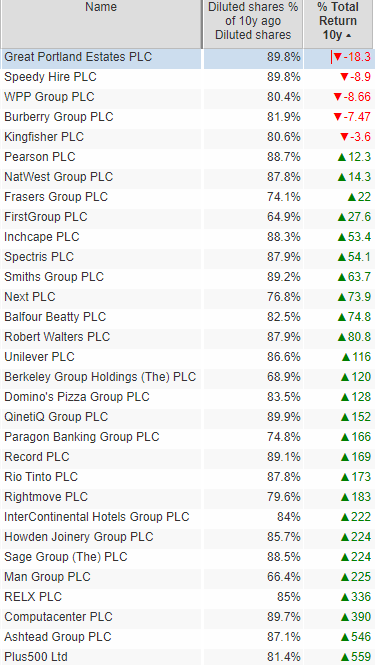This week, a podcast that Jamie listened to inspired a little research project, which reiterated an important lesson in investment. He asks what makes a good business and what impact buying back of company shares has or hasn’t had over the last ten years.
I listened to a podcast, recently where the host interviewed a rather obscure American fund manager; I’ve decided against divulging which podcast as I’m not particularly complimentary. His style was fairly familiar to anyone who has an interest in investment. If I were being flippant, I might describe it as just another Buffett wannabe. His website even has frequent mentions of the Sage of Omaha himself, including direct quotes. In the case of the American fund manager on the podcast, and as is so often the case with US-domiciled funds, there is scant performance data although we are assured that it is excellent. This sent me down two rabbit holes of thinking. The first was one I regularly go down, which is how to identify a well ran business such as those espoused by Buffett (I will talk about the second further down).
The appeal of Warren Buffett to investors (amateur and professional alike) is the ease with which one can understand the basic concepts. As well as being an excellent investor, he is also a fantastic communicator and one that is very open. However, despite the superficial simplicity of his communicated approach, I believe there is considerably more sophistication in Buffett’s approach behind the scenes than most realise. This makes it far harder to ape his style than one might assume, yet he remains the go-to guide for many investors.
Understanding what some of the other savants of the investment world are trying to achieve can be very challenging, and the fact that they are often closed off and secretive makes it all the more so. One such investment savant, Mark Spitznagel, wrote possibly the worst investment book that I’ve read; Dao of Capital: Austrian Investing in a Distorted World. He clearly has incredible talent but unless you enjoy reading page after page about how a branch of a tree blows in the wind, I would avoid. It’s as if Herman Melville had written an investment book – very clever but nearly impenetrable.

But not so with Mr Buffett, not only are some of his quotes easy to understand, but they are witty and, even funny at times too. It doesn’t take a great deal to understand that the meaning of ‘price is what you pay, value is what you get’; don’t overpay and focus on the value of what you buy not the price. ‘Only when the tide goes out, can you see who’s swimming naked’ means excessive risk takers get found out when bad things happen. ‘Be fearful when others are greedy and be greedy when others are fearful’, this last one means do the opposite of what everyone else is doing.
Returning to the fund manager on the podcast, his style was that of a quality investor and not paying too much. A story I’ve heard countless times before. He had, however, made the leap that many others haven’t, which is that the quality aspect of an investment comes mainly from the stewardship. That is to say that the company’s managers are always the most important determinant of how well a business performs. Ultimately, he was looking for a management team that has a sensible policy to capital allocation. His ways of determining this included the willingness to engage in share buybacks as evidence of a quality management team. I.e., good company managers engage in share buybacks – a practice that reduces the share count and thereby theoretically increases the value of remaining shares.
This is odd because he is an American fund manager who crucially invests primarily in US equities. One defining feature of the US stock market that is absent in the rest of the world is the ubiquity of companies buying back their shares as a standard capital allocation decision. That is to say, in the US share buybacks are incredibly common and therefore it is difficult to see how it can be used as a factor in determining the relative quality of a selection of US equities. However, this sent me down my second little rabbit hole to see if share buybacks, in places where it is rare, are a signifier of quality business management and investment returns. In the UK, share buybacks are rare so it seemed a good place to research.
On Buy Backs
What I did
Using SharePad, I created two additional columns on the FTSE All-Share. The first was a way of determining change in share counts; this was done through a custom column, which found the number of shares today as a percentage of the number of shares ten years ago. A number of 75% here would indicate the company has 75% of the number of shares it had ten years ago and therefore had bought back 25% of its share capital (note; this is adjusted for consolidations and splits). A number of 100% would indicate that the company has the exact same number of shares today as ten years ago. A number of 150%, would indicate a 50% increase in the number of shares outstanding i.e., a company that had issued more shares and thus diluted the value to each individual share.
The second column was a simple total return including dividends reinvested with a filter added to eliminate companies that had not been on the stock market for the full ten years.
I then compared the two to attempt to understand whether these companies engaging in buybacks had added any value relative to those companies for which the share count had either remained static or gone up.
What I found
Of the 437 stocks on the FTSE All-Share that have been listed for at least ten years, 147 had a reduced share count. Here’s a summary table showing the number of companies that had reduced their share counts by different percentages. Overall, the majority of companies had the lowest amount of share buybacks, which should be expected with it being a rare thing to occur in the UK.
| Amount share count had reduced | Number of companies |
| Between 40% and 50% | 7 |
| Between 30% and 40% | 15 |
| Between 20% and 30% | 14 |
| Between 10% and 20% | 36 |
| Less than 10% | 75 |
The first thing to note is that the ones that had bought back the most were dominated by investment trusts; of the 30 biggest reductions (which ranged from 24.2% to 48.8%), 26 were investment trusts.
This phenomenon is a reflection of the sad state of investment trusts, which are falling foul of legislation regarding liquidity, which is forcing mass divestment by institutions. To ensure that the share prices are roughly in line with the Net Asset Values (NAVs), the investment trust sector is being forced to keep buying back its shares to offset these liquidations. Unfortunately, this makes them even more illiquid forcing more selling – a vicious circle.
Removing investment trusts from the equation halved the number of shares that have engaged in share buybacks. To further refine the group, we will focus on only those companies that have bought back at least 10% since this low number doesn’t represent much of a change in the context of the last decade. Our final list is therefore 31 shares. For context, over the period of the last ten years, the FTSE All Share had a total return of 79%, including dividends reinvested. This therefore represents the hurdle in return to determine whether a company that serially engaged in share repurchases has done so to the benefit of its shareholders.
Of the 31 companies, fourteen underperformed the index, with the worst performance coming from Great Portland Estates at -18.3% following a 10.2% reduction in shares. This was joined in the negative performance club by four others, Speedy Hire, WPP, Burberry and Kingfisher. The best performing was Plus 500, which has returned +559% on an 18.6% reduction in shares, although Ashtead was a very close second with 546% returned on a 12.9% reduction in the share count. In total, eight companies generated returns in excess of 200% and could be considered big successes.
The entire list is produced below.

Conclusions
It is difficult to see how, even in the UK, the presence of share buybacks in capital allocations is a good indicator of success taken on its own and therefore should be used as part of a more sophisticated set of analytical tools. If one were to have put an equal amount in each share ten years ago, you would have enjoyed a 140% total return, so you might be tempted to say that it’s clearly a successful strategy. However, this assumes that an investor never rebalances anything for ten years. This is unrealistic since many of the best performers have looked, or currently look, expensive. The reverse is true of the poor performers and the real temptation is to trim your ‘expensive’ large weightings and top up your ‘cheap’ small weightings.
Perhaps the lesson there is to run your winners and cut your losers – easier said than done when psychology comes into play.
Of particular interest to me is the position of Next. The management of Next are undoubtedly super high quality and have a logical process that determines when they buy back shares. As evidenced by its 23.2% reduction in shares, Next has been one of the biggest repurchasers during the period, yet this has yielded little more than mediocre returns. So even when you have found good management running a good business, you can still end up with lacklustre results.
Returning to our American friend who appeared on the podcast and believed that share buybacks were an important determinant of a well-run business. It seems, that even in the UK, where buybacks are rare, little can be gleaned from their presence. I would bet that Warren Buffett, who whilst witty, rarely articulates just how much complexity goes into his own investment decisions and thus a simple heuristic of ’I buy well-run businesses that are buying back shares’ is not enough. As investors, we must always strive for betterment and never eschew disparate ways of generating returns. Mr Buffett is hugely talented but there are many others to learn from and emulate so it is important to look beyond Omaha, Nebraska – the home of Mr Buffett.
~
Jamie Ward
Jamie owns shares in Next and NatWest.
Got some thoughts on this week’s article from Jamie? Share these in the SharePad chat. Login to SharePad – click on the chat icon in the top right – select or search for a specific share.
This article is for educational purposes only. It is not a recommendation to buy or sell shares or other investments. Do your own research before buying or selling any investment or seek professional financial advice.




